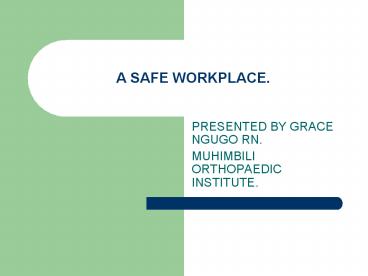A SAFE WORKPLACE. - PowerPoint PPT Presentation
1 / 17
Title:
A SAFE WORKPLACE.
Description:
A SAFE WORKPLACE. PRESENTED BY GRACE NGUGO RN. MUHIMBILI ORTHOPAEDIC INSTITUTE. INTRODUCTION. ... Write a policy that emphasizes what safety means to your ... – PowerPoint PPT presentation
Number of Views:175
Avg rating:3.0/5.0
Title: A SAFE WORKPLACE.
1
A SAFE WORKPLACE.
- PRESENTED BY GRACE NGUGO RN.
- MUHIMBILI ORTHOPAEDIC INSTITUTE.
2
INTRODUCTION.
- Business owners have the absolute responsibility
for the day-to-day health, safety and welfare of
employees and worksite visitors. - To make your work place safer, know the three
common areas of risk - people,
- environment and
- company.
3
EIGHT TIMELESS WAYS TO BUILD SAFETY WORKPLACE.
- Management commitment.
- Accountability.
- Employees involvement.
- Hazard identification.
- Hazard control.
- Accident and incident investigation.
- Training.
- Evaluation.
4
MANAGEMENT COMMITMENT.
- Write a policy that emphasizes what safety means
to your organization/institute. - Establishes your commitment to a safe, healthful
workplace. - Dedicate the time and resources necessary for
employees to achieve safety goals. - Give the employees the authority they need to
carry out their safety responsibility.
5
ACCOUNTABILITY.
- Write a disciplinary policy that has clear
workplace safety expectations for all employees. - Hold supervisors responsible for the developing
proper attitudes for workplace safety. - Establish a recognition program that rewards
employees for their contributions to the safety
effort.
6
EMPLOYEES INVOLVEMENT.
- Employees should have a way to report hazards or
make safety suggestions. - Employees suggestions can help to determine what
resources are necessary to achieve safety goals. - Employees can recommend training topics and
develop training plans. - Employees can help evaluate the effectiveness of
emergency procedures.
7
HAZARDS IDENTIFICATION.
- Conduct a baseline workplace hazards survey.
- Perform regular workplace inspections.
- Watch for hazards.
- Document workplace injuries and illnesses.
8
Cont.
- Look for new hazards whenever you change
equipment,materials, or work processes. - Periodically invite safety professionals to
evaluate. - Use material safety data sheets to identify
chemical hazards
9
HAZARD CONTROL.
- Use engineering controls and consider and
administrative. - Enforce workplace safety rules.
- Ensure that employees know when and how to use
personal protective equipment. - Practice good housekeeping.
- Plan for emergencies.
10
CONT.
- Practice good housekeeping.
- Plan for emergencies.
- Maintain equipment on schedule.
- Document how you control hazards.
11
ACCIDENT AND INCIDENT INVESTIGATION.
- Investigating accidents-develop a procedure that
determine who will do the investigation
accurately. - Investigating incidents-employees should be told
what will be done to prevent an accident.
12
TRAINING.
- All employees-New employees should have
orientation training that covers your business. - Supervisors-supervisors must know the hazards,
emergency procedures associated with their job. - Managers-managers need to understand the
importance of leadership in achieving and
maintaining a safe workplace.
13
EVALUATION.
- Evaluate your safety effort. Are you achieving
your goals? If not what are the reasons? - Did the reports identify causes and recommend how
to control or eliminate them? - Does your workplace have hazadous chemicals, loud
machinery, equipment that may need to be locked.
14
CONCLUSSION.
- Every employee has the right to work in a safe
environment. Which requires employers to protect
the health and safety of their workers and the
occupational environment. - That includes air quality, lighting, exposure to
infectious or toxic areas, and other hazards.
15
CONT..
- Under these regulations, employees have the
specific right to information about any hazards
they could encounter in their workplace. - They also have the right to question the employer
about any health and safety concerns they may
have, and the right to refuse work if they
believe their safety or health is at risk.
16
REFFERENCES.
- Web site www.orosha.org.
17
A SAFE WORKPLACE IS A SMART BUSNESS. THANK YOU.































